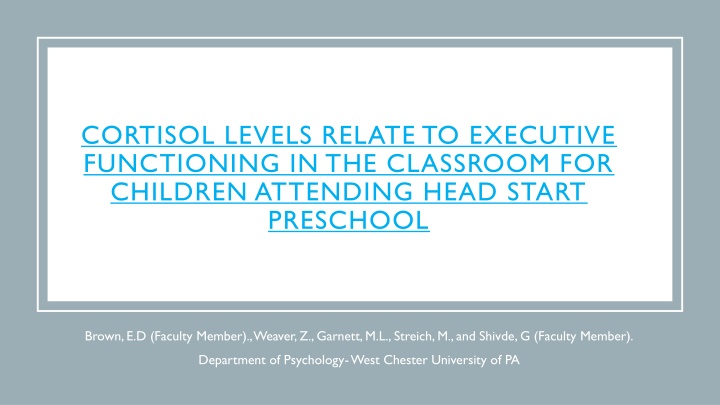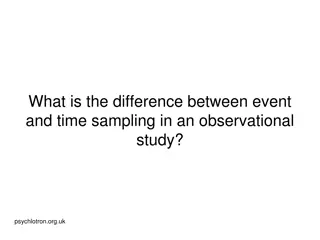
Cortisol Levels and Executive Functioning in Head Start Preschoolers
Explore how cortisol levels relate to executive functioning in Head Start preschool children. Understand the impact of poverty on cognitive development, focusing on socioeconomic disparities in executive functioning. Learn about the role of physiological stress in explaining these disparities, including the effects of the HPA axis on neurodevelopment.
Download Presentation

Please find below an Image/Link to download the presentation.
The content on the website is provided AS IS for your information and personal use only. It may not be sold, licensed, or shared on other websites without obtaining consent from the author. If you encounter any issues during the download, it is possible that the publisher has removed the file from their server.
You are allowed to download the files provided on this website for personal or commercial use, subject to the condition that they are used lawfully. All files are the property of their respective owners.
The content on the website is provided AS IS for your information and personal use only. It may not be sold, licensed, or shared on other websites without obtaining consent from the author.
E N D
Presentation Transcript
CORTISOL LEVELS RELATE TO EXECUTIVE FUNCTIONING IN THE CLASSROOM FOR CHILDREN ATTENDING HEAD START PRESCHOOL Brown, E.D (Faculty Member)., Weaver, Z., Garnett, M.L., Streich, M., and Shivde, G (Faculty Member). Department of Psychology-West Chester University of PA
INTRODUCTION o Approximately 15 million children in the United States grow up in poverty (National Center for Children in Poverty, 2018) o The impact of poverty circumstances on learning and social-emotional development in children (Duncan & Brooks-Gunn, 1997) o Socioeconomic status disparities in Executive Functioning for explaining these outcomes. o Fitzpatrick and colleagues (2014)- academic success Aspects of EF (e.g., working memory, cognitive flexibility, inhibitory control and attention shifting) predict variance in preacademic school readiness that is unique from that predicted by measures of general intelligence and processing speed. o O' Toole and colleagues (2017)- prosocial relationships EF predicts prosocial behavior and positive peer relationships
EF is a higher order cognitive system comprised of a variety of interrelated yet partially dissociable abilities (Miyake, 2000) such as strategic planning, cognitive flexibility, working memory, attention, regulation of emotions and inhibition of inappropriate or impulsive behavior (Fuster, 2002; Diamond, 2006) EXECUTIVE FUNCTION EF skills in the classroom would serve to help children hold an instruction in mind during a classroom activity, while maintaining the ability to focus on novel stimuli relevant to problem-solving tasks and resisting external or internal distractions (Fitzpatrick et al., 2014)
THE ROLE OF PHYSIOLOGICAL STRESS IN EXPLAINING SES DISPARITIES IN EF Bronfenbrenner (1989)- Contextual risk factors of poverty disrupt the proximal processes in the child s environment that are supportive of EF development (Fiese & Winter, 2010) Physical and psychosocial family instability and home chaos-> poorer self-regulatory aspects of EF (Evans, 2003; Brown et al., 2010) The link between childhood economic hardship and EF difficulties is also partially explained by dysregulation in the hypothalamic-pituitary-adrenal (HPA) axis and associated atypical neurodevelopment (Evans & Kim, 2013; Blair & Raver, 2016) In brain regions critical for EF (Miller & Cohen, 2001)
HPA Axis-primary physiological stress response system. POVERTY CIRCUMSTANCE AND HPA ACTIVITY Activity during early childhood impacts life-long neurophysiological development (Gunnar & Quevedo, 2007) Activity in the HPA axis - frequently measured via its end- product, cortisol, which is a primary glucocorticoid and can be obtained noninvasively through the sampling of hair or saliva (Kronenberg, 2007) Adaptivity of cortisol production is context dependent (McEwen, 2013) Research most consistently demonstrates that early childhood poverty is associated with excessive cortisol production in the HPA axis (Lupien et al., 2001; Evans et al., 2013) Manifestations of HPA dysregulation (excessive or diminished production) in the individual are dependent upon developmental considerations, and the severity, nature and duration of stress exposure (Lupien et al., 2009).
Dysregulated cortisol production is associated with synaptic suppression in PFC in animal models (Joels & Baram, 2009) HPA DYSREGULATION AND THE DEVELOPING PREFRONTAL CORTEX Risk for the development of this brain region as it is undergoing a period of rapid growth or synaptogenesis throughout early childhood (Coley et al., 2015). Localization of EF to the PFC and related circuitry Evidence From Neuroimaging Research (Hanson, et al., 2013)- Observed reductions in grey matter volume in PFC of children in poverty. (Noble et al., 2015)- SES disparities in PFC surface area
Blair and Raver (2013) examined the relationship between children from low-income households basal or morning cortisol levels and performance on measures of EF longitudinally (7 months to 4 years of age). Findings indicate that higher basal cortisol, a single time-point measurement predicted poorer performance on EF measures throughout early childhood. CORTISOL AND EXECUTIVE FUNCTIONING Cortisol reactivity in Head Start Contexts (Blair & Razza, 2005) Typical cortisol reactivity or slight increases in cortisol production followed by down- regulation in response to challenge predicted higher teacher-reported self-control and attention A gap in our understanding of cortisol and EF is that most studies to date have focused on performance-based measures as opposed to assessing EF as manifested in children s classroom behavior
Full day childcare settings such as preschool alter the trajectory of cortisol across the day in middle-high SES children (Vermeer et al., 2006) Unclear in the current literature as to whether similar alterations in typical cortisol trajectories occur in preschool contexts for children in poverty (Hatfield, 2019) Particular poverty risk (home chaos, instability) associated with more typical decrease after midmorning (Eliassan et al., 2012) CORTISOL & PRESCHOOL CONTEXTS Cumulative poverty risk- flattened cortisol trajectory (Zalewski et al., 2012) Importance of childcare and relationship quality (Rappolt-Schlichmann, 2009) Understanding more about how the context of preschool impacts cortisol across the day represents a critical need as preschool is a key context for early intervention, and atypical cortisol production holds significant implications for the development of EF. We know of no studies to date that have examined the relationship between EF and cortisol production across the day in Head Start contexts.
PARTICIPANTS AND PROCEDURE o Procedure o Recruitment o Demographic interview with parents or caregivers o Assessments of child salivary cortisol o Completed at 9 am, 10:30 am, 12 pm, and 1:30 pm o Teacher ratings of child executive functioning o Participants o 310 children who attended preschool in a large city in the Mid- Atlantic region o Mean age of children 4 years, 9 months o 53.5% female o 51.3% African American, 16.l7% Latino or Hispanic American, 11.9% Asian American,20.1% Caucasian or European o 79.2% of children came from households with incomes below the federal poverty guideline; an additional 18.9% came from families classified as low-income o Students prescribed medications that have. been demonstrated to alter cortisol levels were excluded from the study
MATERIALS AND MEASURES o Demographic Interview by Ackerman, Brown, & Izard (2003) o Provided information about standard indicators such as child age, sex, race and ethnicity, family size and household income o BRIEF (Gioia, Isquith, Guy & Kenworthy, 2000) o Obtain structured ratings of children's EF in academic context o Subdomains o Shifting o Imitation o Inhibition o Emotional Control and Working Memory o Planning/Organizing and Monitoring o Cortisol o 510-k cleared high-sensitive enzyme immunoassay, a biochemical test for the concentration of cortisol in saliva (Salimetrics, LLC, State College, PA) o AUCg (Area Under the Curve with respect to ground) AUCG= (m2+m1) t12+(m3+m2) t22+(m4+m3) t32
Variable 1 2 3 4 5 6 7 8 9 10 11 12 13 14 15 16 1. Age (Months) - 2.Sexa-.04 - 3. Race/Ethn. .01 .16**- 4.Care/Needs .07 -.07 .09 - 5. Cortisol .07 -.04 .11 .10 - 6.BT(inhibit) .18**.12**.02 .17** .19**- TABLE 2 7.BT(shift) .25**.06 .08 .11 .25** .89**- CORRELATIONS AMONG STUDY VARIABLES 8.BT(emotion) .21**.06 .03 .17**.20** .91** .94**- 9.BT(initiate) .23**.05 .07 .09 .26** .82**.88** .83**- T H I S T A B L E S H O W S T H E Z E R O - O R D E R C O R R E L A T I O N S B E T W E E N T H E I N D E P E N D E N T V A R I A B L E S A N D T H E T E A C H E R R E P O R T S O F E X E C U T I V E F U N C T I O N I N G ( B R I E F ) . 10.BT(mem.) .26**.11 .09 .08 .31** .83**.89** .82**.92**- 11.BT(plan) .28**.11*.08 .09 .29** .83** .92**.84**.93**.97**- 12.BT(org.) .21**.08 .04 .12* .30** .85** .88**.85**.85**.88**.89**- 13.BRIEF(BTM) .24**.11 .06 .14* .25** .92** .92**.88**.92**.93**.94** .91** - 14.BRIEF(BRI) .22**.08 .04 .15**.22** .97** .97** .98**.87**.87**.89**.89** .94**- 15.BRIEF(MI) .26**.10 .08 .11 .29** .88** .93**.87**.95**.98**.98** .93**.98** .93**- 16.BRIEF(GEC) .25**.09 .06 .13* .27** .93** .96** .93**.94**.95**.96**.93** .98** .97**.99**- a0=female, 1=male. 1=racial/ethnic minority *p < .05.**p < .01.
BRIEF(GEC) B ` SE BR2() R Model .15 .14*** Constant -.698. .44 Age .031*** .01 .24*** Sex .237* .11 .12* TABLE 3 Race/ethnicity .014 .13 .01 MULTIPLE REGRESSION RESULTS FOR BRIEF(GEC) Family Income .119 .07 .10 Cortisol .005*** .001 .25*** T H I S T A B L E D I S P L A Y S R E S U L T S O F A R E G R E S S I O N A N A L Y S I S E X A M I N I N G C H I L D D I N U R A L C O R T I S O L A S A P R E D I C T O R O F T H E B R I E F G E N E R A L C O M P O S I T E S C O R E , C O N T R O L L I N G F O R D E M O G R A P H I C C O V A R I A T E S . *p < .05.**p <.01.***p < .001.
Results support primary hypothesis- higher cortisol output across the day-> greater difficulties in teacher-reported EF. Additional findings- consistent with previous literature DISCUSSION Limitations and Future Directions Implications for policy and practice Alleviating stress and supporting the development of self-regulatory skills.
REFERENCES Ackerman BP, Brown ED. Physical and psychological turmoil in the home and cognitive development. In: Evans GW, Wachs TD, editors. Chaos and its influence on children s development: An ecological perspective. Washington, DC: American Psychological Association; 2010. pp. 35 47. Blair, C., & Raver C. C. (2016). Poverty, Stress, and Brain Development: New Directions for Prevention and Intervention. Academic Pediatrics. 16, 530-536. Blair, C., & Razza, R. P. (2007, March). Relating effortful control, executive function and false belief understanding to emerging math and literacy ability in kindergarten. Child Development,78(2), 647 663. doi:10.1111/cdev.2007.78.issue-2. Bronfenbrenner U. Ecological systems theory. In: Vasta R, editor. Annals of child development, Vol. 6. Six theories of child development: Revised formulations and current issues. London: Jai; 1989. pp. 187 249. Coley, R.L., Lynch, A.D., and Kull, M. (2015). Early exposure to environmental chaos and children's physical and mental health. Early Child Res Q. 2015; 32: 94 104 Diamond, A. (2006). The early development of executive functions. In E. Bialystok & F. I. Craik (Eds.), Lifespan cognition: Mechanisms of change (pp. 70 95). New York, NY: Oxford University press. Duncan G, Brooks-Gunn J. 1997. Consequences of Growing Up Poor. New York: Russell Sage Found. Evans, G.W., & Kim, P. (2013). Childhood poverty, chronic stress, self regulation, and coping. Child Development Perspectives, 7 (1), 43 48. Fiese, B, Winter, M. The dynamics of family chaos and its relation to children's socioemotional well-being. In: Evans GW, Wachs TD, editors. Chaos and its influence on children's development: An ecological perspective. American Psychological Association; Washington, DC: 2010. pp. 49 66. Fitzpatrick C, McKinnon R, Blair C, Willoughby M (2014) Do preschool executive function skills explain the school readiness gap between advantaged and disadvantaged children? Learn Instr 30: 25 31. Fuster, J. M. (2002). Frontal lobe and cognitive development. Journal of Neurocytology,31, 373 385.
REFERENCES Hanson, J., Hair, N., Shen, D. (2013) Family poverty affects the rate of human infant brain growth (2013), p. E80954. Jo ls, M., & Baram, T. Z. (2009). The neuro-symphony of stress. Nature Reviews Neuroscience, 10(6), 459 466. doi: 10.1038/nrn2632. Kronenberg H, Melmed S, Polonsky KS, Larsen PR. Williams Textbook of Endocrinology. Saunders Elseviers: Amsterdam, the Netherlands, 2007. Lupien, S. J., King, S., Meaney, M. J., & McEwen, B. S.(2001). Can poverty get under your skin? Basal cortisol levels and cognitive function in children from low and high socioeconomic status. Development and Psychopathology, 13, 653 676. McEwen, B. S., Morrison, J. H. (2013). The brain on stress: Vulnerability and plasticity of the prefrontal cortex over the life course. Neuron, 79, 16 29. Miller, E. K., & Cohen, J. D. (2001, March 1). An integrative theory of prefrontal cortex function. Annual Review of Neuroscience, 24(1), 167 202. doi:10.1146/annurev.neuro.24.1.167 Noble, K. Houston, S., Brito, E., et al. (2015). Family income, parental education and brain structure in children and adolescents.18. 773-778. Sapolsky, R.M., Romero, L.M., Munck, A.U., 2000. How do glucocorticoids influence stress responses? Integrating permissive, suppressive, stimulatory, and preparative actions. Endocr. Rev. 211, 55 89.






















